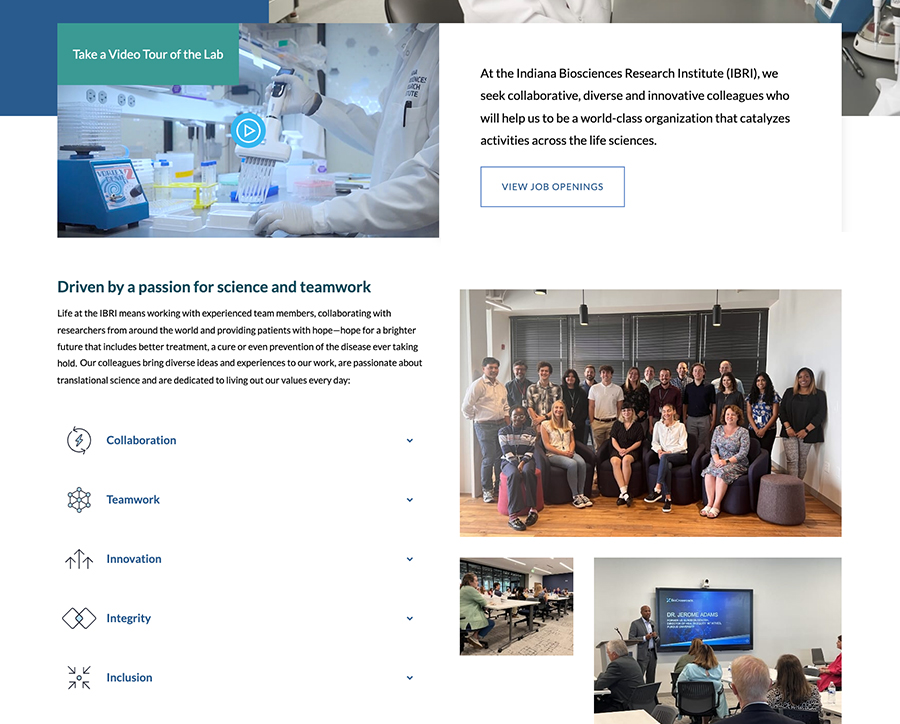Your careers page might be the most important web page no one’s thinking about. In today’s hiring landscape, recruitment marketing is as essential as customer marketing, and strong careers page examples bring it all together.
Job seekers behave like savvy consumers: they shop around, read reviews, and browse multiple “brands” before deciding where to apply. If your page is hard to navigate, thin on culture, or bland in tone, you’re likely losing candidates before they even hit “apply.”
Keep reading to explore 15 standout careers page examples, learn what makes them work, and find inspiration for upgrading your own page to attract the right candidates. Interested in other articles from this series? Check out:
- Bringing proven marketing techniques to your hiring process
- Writing job descriptions for better engagement
- Using recruitment marketing automation to reach top talent
What job seekers want from your careers page
Strong careers page examples work like popular tables at job fairs. Even though they’re surrounded by impressive competitors pulling out all the stops to get attention, they are consistently visited by the most impressive job seekers in the field.
Yet, there’s just one big difference between a company’s table at a jobs fair and its website’s careers page: Candidates can be much pickier about where they invest their time and interest online.

Your careers webpage isn’t just a box to check off or a stop along the hiring funnel. It’s a strategic moment where your employer brand either connects or falls flat. In fact, 75% of job seekers consider an employer’s brand before even applying for a job. They want more than just a list of generic bullet points or an unspecific job description marketing blurb.
Compelling careers page examples showcase company values and team culture, while also demonstrating whether it’s a place where new employees can thrive. If your website’s careers page doesn’t provide a clear, engaging picture of what it’s like to work at your business or organization, many top candidates won’t take the next step. So, before diving into career page examples, let’s cover the must-haves for a high-performing careers landing page on your website.

A clear sense of culture
- Why it matters: Company culture is a significant factor for job seekers when evaluating potential employers. For instance, 46% of job seekers consider company culture very important when choosing to apply to a company, and 88% find it at least relatively critical.
- What to do: Showcase your organization’s values, mission, and work environment through authentic storytelling and behind-the-scenes content. This transparency helps candidates assess alignment and fosters trust.
Pro tip: Do a vibe check! When hiring is challenging and you have to fight the competition to attract top talent, great content isn’t enough. Job seekers are busy, so one way to stand out is to design your website’s employment opportunities info to look good, too. In the careers page example below from Angi, the company uses memorable and welcoming custom illustrations to reinforce its culture messages.

Mobile-friendly design
- Why it matters: With 67% of candidates using mobile devices to apply for jobs, a mobile-optimized careers page is essential. The best careers page examples work as well on a phone as they do on a desktop.
- What to do: Ensure your careers page is responsive and loads quickly on all devices by simplifying navigation and application processes for mobile users. Taking these small steps will help reduce drop-off rates.
Pro tip: Ensure your interactive features are accessible to all users. If you go to the trouble of creating features to engage with job seekers, don’t forget to test them on tablets and smartphones. In the careers page example below from Republic Airways, its interactive career opportunities map works just as well on tablets as it does on laptops and desktop computers because they took the time to optimize for multiple displays.

Easy access to open roles
- Why it matters: Job seekers are often fighting job ad fatigue and value efficiency. A complex or cluttered job search experience can deter potential applicants.
- What to do: Organize job listings with clear categories, filters, and search functionality. User-friendly career page examples clearly highlight key information, such as location, department, and employment type, to help candidates quickly find relevant positions.
Pro tip: Keep your website’s recruitment marketing info up-to-date. If a job opening has been filled, remove it from the list. If your company has a new identity or updated brand messaging guidelines, ensure that your careers pages are revised to reflect these changes. And, if you have news that impacts candidates, be sure to post this information on your site, just as Simon does in the example below with its fraud alert announcement callout box.

Employee testimonials
- Why it matters: Candidates trust the insights of current employees. In addition to building trust, employee testimonials visibly prove that employee opinions matter.
- What to do: Incorporate authentic employee testimonials in various formats—videos, quotes, or blog posts—to provide real perspectives on the work environment and culture.
Pro tip: Add awards as additional social proof to enhance your credibility. In the careers page example below from Grainger, rather than including a line in their copy that says it’s a great place to work, there’s a panel of impressive award graphics on the career page that tells this story while also adding visual interest to the layout.

4 careers page examples worth learning from
Think of your careers page as the digital front porch of your workplace. It’s where you invite candidates in, share your story, and help them envision their future as part of your team. In the following career page examples, the messaging, visuals, and layout feel fresh and exciting, encouraging job seekers to invest their valuable time and attention in the application process.
Doist: Clean, global, and values-first


Doist’s careers page leads with what matters: mission, autonomy, and flexibility. Their culture and values aren’t an afterthought—they’re the headline. Remote applicants immediately understand how Doist operates and what kind of team they’ll join, making it one of the strongest careers page examples for companies seeking to attract global, remote-first talent.
Why it works:
- Values-driven storytelling right up top
- Friendly, human tone throughout
- Detailed breakdown of perks and work style
Pro-tip: Don’t forget about findability. If hiring is a priority, ensure your recruitment marketing content is easily accessible by adding a link to the main top navigation or bottom footer navigation menu. Morales, as shown in the examples below, includes links in both spots, using text links and stylized buttons.

TaskRabbit: Visual, clear, and candidate-focused


TaskRabbit’s company careers pages use strong imagery and inviting copy to draw visitors in. They highlight their teams, open roles, and diversity commitments with crisp, branded design that works well across devices. It stands out among careers page examples for its ability to blend visual storytelling with easy navigation and inclusive messaging.
Why it works:
- Clear structure and visual hierarchy
- “Why work here?” content tailored to job seekers
- Links to team stories, benefits, and blog posts
Florida Orthopaedic Institute: Recruitment with heart


Healthcare is a competitive field, and this career page effectively demonstrates how to highlight stability and purpose. Florida Orthopaedic Institute’s website careers content features straightforward language, employee testimonials, and intuitive navigation to appeal to job seekers seeking a mission-driven workplace. It’s one of the more human-centered careers page examples, especially within the healthcare sector.
Why it works:
- Prominent employee testimonials
- Focus on mission and team culture
- Simple UX with quick access to openings

Indiana Biosciences Research Institute: Purposeful and localized

IBRI’s careers website content demonstrates how a research-driven organization can use storytelling and structure to attract top STEM talent. The design is straightforward yet intentional, highlighting the unique career paths and impact opportunities available in Indiana’s growing life sciences sector. It’s one of the most effective careers page examples for organizations that want to showcase both scientific rigor and regional relevance.
Why it works:
- Strong mission language focused on improving health
- Fluff-free descriptions of culture, benefits, and team structure
- Regionally grounded with global relevance
Stronger careers page must-haves
If your page feels lackluster compared to those careers page examples, it might be time for a quick self-audit against best practices. Review your current website to evaluate your use of the following types of career webpage content.
Employee testimonials
If you have testimonials, ensure they remain relevant and come from current employees. Collecting testimonials—whether in video, audio, or written format—can be simple. Share a survey with your team to gather them in one digital place.

Pro-tip: Don’t overthink your multimedia employee career testimonials. Simple, phone-recorded testimonials can often feel more real and relatable than polished corporate video reels.
Messaging and visuals
Do the messaging and images on your careers page reflect the spirit and energy of your brand? Are you showcasing authentic team moments or relying on stock imagery?
Pro-tip: Cross-check the messaging and visuals on your careers page with your brand style guide to ensure alignment. Use authentic photos to help candidates feel connected to your team. On Cummins’ careers page (shown below), there’s no question that you’re on their site because the branding is consistent with how the company presents itself elsewhere digitally and in print.

Load times and mobile optimization
Candidates are often researching roles on the go, between tasks, or after hours on their phones. The strongest careers page examples are fast-loading on mobile. If your site loads too slowly for users on smartphones and tablets, you risk losing job candidates before they even start browsing.
Pro tip: Test your careers page on various mobile devices. Try navigating as if you’re a job seeker. Can you easily find open roles and apply with a few taps? If not, it’s time for a tune-up.
Benefits and career development
Today’s job seekers want more than a paycheck—they want to know what growth looks like. Providing a clear and accessible overview of benefits, perks, and professional development opportunities can be a significant differentiator.
Pro-tip: Strategic careers page examples organize benefits around themes, like “support for your health,” “growth opportunities,” or work-life balance” to help candidates quickly see what aligns with their priorities. And, if you’re really going all-in, consider creating a blog, like Zylo has done on its careers microsite shown below, to give all of this content a searchable home.

Dynamic features
Not every visitor is ready to apply on their first visit. Innovative recruitment marketing automation features, such as AI-powered chatbots and personalized job recommendations, keep candidates engaged and help them find roles that align with their interests.
Pro-tip: If you use a chatbot, make sure it feels human and helpful, not robotic or pushy. You can also include an option to connect with a real recruiter for that added personal touch.
Making your website more recruitment-friendly
At TBH Creative, we help organizations—from healthcare systems to tech startups—design careers pages that attract top talent and drive application submissions.
If your hiring page is stuck in the past or you’re losing candidates before they apply, it might be time for a refresh. Our experts can help you turn your careers page into the recruiting asset it should be. Let’s talk.

